Archive:Internet access and use statistics - households and individuals
- Data extracted in December 2016. Most recent data: Further Eurostat information, Main tables and Database. Planned article update: December 2017.
This article presents an overview of the findings of the 2016 ‘Survey on ICT (information and communication technology) usage in households and by individuals’. It takes a closer look at the type of internet connection used by households, as well as at internet users’ activities.
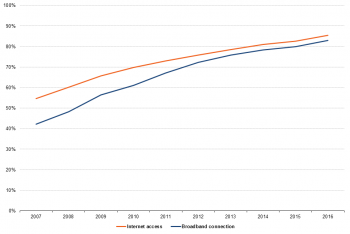


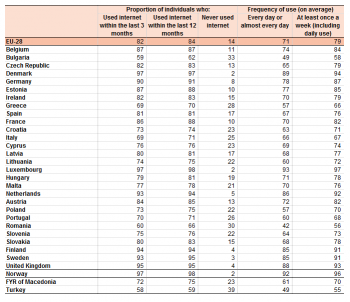
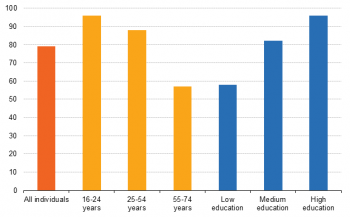
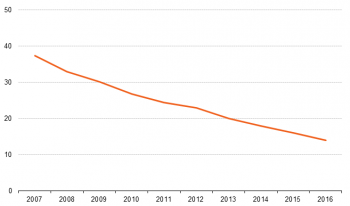

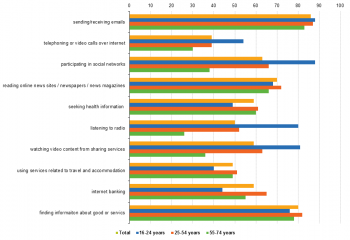
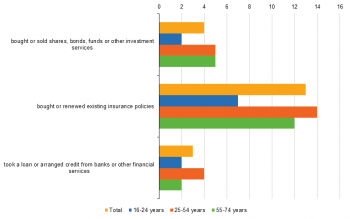
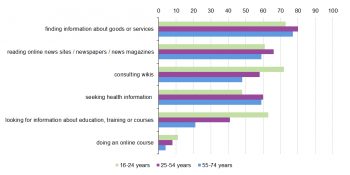

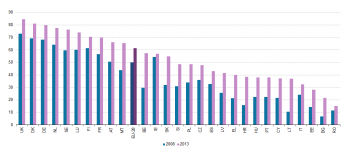
Main statistical findings
A large majority of Europeans have used the internet in 2013. It has become important for daily life, education, work and participation in society and enables people to access information and services at any time from any place. Most internet users search for information and news, consult wikis, participate in social networks and buy products online.
In 2013, two in five individuals aged 16-74 years in the EU contacted or interacted with public authorities or public services via websites for private purposes. Among those who used e-government services, income tax declaration was a major reason for use.
The internet habits of different countries and socio-economic groups vary significantly. About a fifth of the EU population have never used the internet.
Internet access
In 2016, 85% of the European households had access to the internet from home. This share has been gradually increasing since 2007, when only 55% of the households had access to the internet (Figure 1).
Broadband connection is the most common technology for accessing the internet in the EU: in 2016, 83% of the households (97% of the household having internet access) had a fixed and/or mobile broadband connection. Over the last ten years, the percentage of households connecting to the internet with the broadband almost doubled. Furthermore, in 2016 it increased of additional two percentage points respect to 2015.
At the EU-country level, the largest shares of households having access to the internet (Figure 2) were registered in Luxembourg and the Netherlands (97% each). Five other countries presented shares of connected households above 90%: Denmark and Sweden (94 % each), the United Kingdom (93%), Germany and Finland (92% each). At the other end of the ranking scale, the lowest proportions were registered in Bulgaria (64%) and Greece (69%) followed by Romania and Lithuania (72%).
Between 2010 and 2016 important increases (more than 30 percentage points) of the share of households connected to the internet occurred in Bulgaria and Romania though remaining at the end of the scale. Spain, Greece, Hungary and Czech Republic also registered significant increases (more than 20 percentage points) in the same period.
Figure 3 shows the shares of broadband access by country. Luxembourg is the country that displayed also the highest proportion of households with broadband connection (97%). Shares higher than 90% were also registered for the Netherlands (95%), Denmark and United Kingdom (92% each) and Finland (91%). Lowest broadband connectivity rates were registered for Bulgaria (63%), Greece (68%), Romania (70%) and Lithuania (71%).
Internet use by individuals
Three quarters of Europeans used the internet in 2013
Three quarters of individuals (75 %) in the EU used the internet at least once in the three months prior to the survey. Seven out of ten (72 %) had used it regularly (on average at least once a week) at home, at work or elsewhere (table 1), a level of use just three percentage points below the Digital Agenda target of 75 % of the population by 2015. The share of daily users among internet users was high in all Member States, Iceland and Norway. In the EU, 62% of all individuals used the internet every day or almost every day.
There was significant divergence ('digital divides') according to age and level of formal education (figure 1). 94 % of those aged 16-24 were regular internet users, more than double the proportion in the 55-74 age group (46 %). Similarly, the figure for individuals with a high level of education (93 %) was nearly twice that for those with a low level of education (48 %).
In the EU, the proportion of individuals who have never used the internet halved from 42 % in 2006 to 21 % in 2013 (figure 2), though this trend has slowed in recent years: the number fell from 24 % in 2011 to 22 % in 2012 and 21 % in 2013, and is still six percentage points above the Digital Agenda 2015 target of 15 %.
Large digital divides remain as regards levels of non-use by country (figure 3). The highest proportions of the population with no experience of internet use (whether at home, at work or elsewhere) were registered in Romania (42 %), Bulgaria (41 %) and Greece (36 %), and the lowest in Denmark and Sweden (4 %), the Netherlands and Luxembourg (5 %) and Finland (6 %). In four Member States (Italy, Cyprus, Portugal and Poland), about a third of the population are non-users.
Internet activity by age group
Communication by e-mail is more or less equally important for internet users in all age groups (figure 8). Larger differences between young and old were recorded when it came to other communication activities covered by the survey, such as social networking and telephone or video calls over the internet. The share of internet users who participated in social networking was 89 % for 16-24 year olds compared with 27 % for 55-74 year olds. The share of users making telephone and video calls through internet-based applications was 45 % for the age group 16-24, compared with 25 % for 55-74 year olds.
The internet is widely regarded as a source of information and knowledge. More than 70 % of users in all age groups in the EU searched for information about goods or services (figure 9). Many young people used the internet as learning support. Most internet users aged 16-24 consulted wikis (72%), looked for information about education, training or course offers (63%) and read online news (61 %). One in ten young internet users took an online course.
Most internet users in the age group 25-54 read online news (66 %), searched for health information (60 %) and consulted wikis (58 %). These activities were also popular among internet users aged 55-74: nearly 60 % read online news and searched for information about health, and about half consulted wikis.
While over 50 % of internet users aged between 16 and 54 used social networking sites, fewer than one in five used such sites, blogs and e-government or other websites to post opinions on civic or political issues (figure 10). In the 55-74 age group, one in ten users posted such opinions.
A small proportion of internet users took part in online consultations or votes on civic or political issues (e.g. urban planning, signing a petition). One in ten participated in policy decision-making processes.
Data sources and availability
The data in this article are based on the results of annual surveys on ICT usage in households and by individuals. Data for 2016 were aggregated from micro data transmitted by all Member States and some non EU countries (Norway, the former Yugoslav Republic of Macedonia and Turkey). They are available on the Eurostat website (see link below). Researchers can apply for access to the micro data.
The 2016 survey results are based on responses from a total of 156 152 households containing at least one person aged 16-74, and 203 798 individuals aged 16-74 across the EU. Individuals were asked about the last time they used the internet, how often they used it, on which devices, use away from home or usual place of work, activities relating to e-government and e-commerce, e-skills and privacy and protection of personal identity.
In general, internet activities were carried out in the previous three months before the interview. The main reference period was the first quarter of 2016, as in most countries the data were collected in the second quarter. A 12-month reference period was used for financial activities.
Levels of education are defined according to ISCED-2011 as follows: high (tertiary, ISCED 5, 6, 7 or 8); medium (upper secondary and post-secondary non-tertiary, ISCED 3 or 4); low (at most lower secondary, ISCED 0, 1 or 2).
Context
The findings of this survey are used for monitoring several EU policies, in particular the Digital Agenda for Europe, which is one of the pillars of the Europe 2020 strategy (which sets objectives for the growth of the European Union by 2020). The Digital Agenda proposes to better exploit the potential of Information and Communication Technologies (ICTs) in order to foster innovation, economic growth and progress. One of its main objectives is the completion of the Digital Single Market, in which the free movement of persons, services and capital is ensured and where the individuals and businesses can seamlessly access and exercise online activities under conditions of fair competition, and a high level of consumer and personal data protection, irrespective of their nationality or place of residence. The completion of the Digital Single Market is currently one of the political priorities of the European Commission. It covers three areas: promoting better online access to goods and services across Europe; designing an optimal environment for digital networks and services to develop; ensuring that the European economy and industry takes full advantage of the digital economy as a potential driver for growth.
At the end of 2015 the European Commission published a framework called Monitoring the Digital Economy and Society 2016–2021. This document describes the main policy developments and outlines the main data requirements to monitor European digital policies, information and communication technologies as well as their impact on the economy and society in the period 2016-2021. It reviews existing data sources and lists new areas and data sources to be made use of in the future.
See also
Further Eurostat information
Data visualisation
Publications
Main tables
Database
Dedicated section
Methodology / Metadata
Source data for tables, figures and maps (MS Excel)
Other information
External links